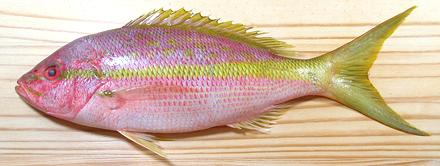 [Ocyurus chrysurus]
[Ocyurus chrysurus]
This true Snapper is found from Massachusetts (rarely) through the Caribbean and along the nortneastern coast of South America as far south as northern Brazil. It can get up to nearly 34 inches long and 9 pounds, but is commonly around 16 inches. The photo specimen was 16 inches and weighed 1 pound 6-3/4 ounces. This snapper is a premium fish and fetches a premium price. Yellowtail Snapper is not considered threatened, IUCN Red List rated NE (Not Evaluated). Some fish are now being farmed. There have been reports of ciguatera poisoning from fish caught in a tropical reef environment.
More on Snapper Family.
Yellowtail Snapper, besides its striking color, is an exceptionally well behaved and tasty fish for all methods of cooking, and this has made it rather expensive. The photo specimen was purchased at a Philippine market in Los Angeles for 2014 US $7.99 per pound. If that's just too painful, see Cardinal Snapper and Lane Snapper.
The flesh is near white with a couple darker streaks just under the skin. It is flavorful enough for fish lovers but not so strong as to deeply offend those who prefer their fish white and flavorless.
Cooking: This is a fine fish for just about any method of cooking: pan fried, steamed whole, baked, poached or in soup. Skinless fillets hold together well enough that whole fillets from fish weighing up to 1-1/2 pounds can be poached and served without breaking up. Fillets can be pan fried skin-on. Fry the non-skin side first to stiffen the fillet, then flip over and pat the fillet down flat with the turner. Once flattened it will stay flat. If you use it in soup, put it in for the last 5 to 10 minutes or it will fall apart.
Scales: The scales are medium size with moderate adhesion, so they scrape off fairly easily with moderate flying about. Unlike most fish, a fair amount of the coloration is in the scales so it'll be a lighter color when they are scraped off.
Cleaning: This fish presents no particular problems in cleaning. The gills pull a little hard, so use long nose pliers.
Fillet: This is a very easy fish to fillet with easy to follow bone structure. There should be almost no flesh left behind. I usually remove the head before filleting. Tilt the knife to get under the gill covers to get as much flesh as possible. There will be a couple small bones you'll need to cut with kitchen shears, and then the backbone. When filleting, minimize bending the flesh as it tends to flake apart.
The rib cage looks easy to follow, but when I get to it I just cut the ribs away from the backbone with kitchen shears and pull them from the fillet using long nose pliers. They pull easily and cleanly. There is a row of substantial centerline spines which need to be pulled, about 7 of them, extending from the front cut to the end of the body cavity.
Skin: The skin has no strong or "off" flavor and shrink is quite moderate so steaming and baking whole fish works well, even without slashes through the skin for moderate sized fish. Fillets can be pan fried skin-on. The skin is thin, but fairly strong, so fillets can be skinned easily using the long knife and cutting board Method. You will loose a small lump of flesh from the skirt, which can be used for some other purpose. The skins can be included with heads, bones and fins for making stock.
Yield: A 1 pound 6-3/4 ounce fish yielded 12-5/8 ounces of skin-on fillet (55%), and 11.62 ounces skinless (52%). This is a pretty good yield.
Stock: The head, bones and fins make a very fine nearly clear soup stock - and you can even toss in the skins for better yield. There is moderate oil, which should be removed - use your gravy separator. This stock is so good that to make a fine fish soup a shake of salt is all the ingredients you need. For details see our Fish Stock page.
sf_snapytz 140302 - www.clovegarden.com